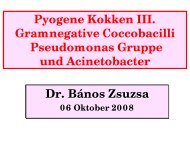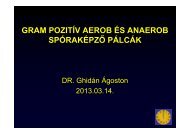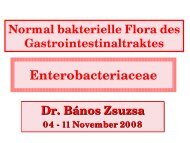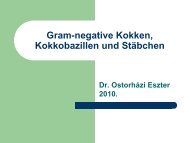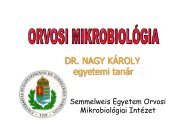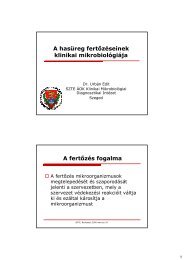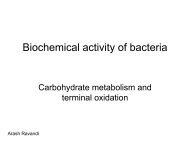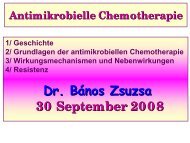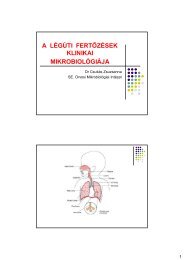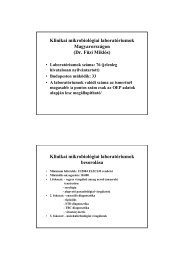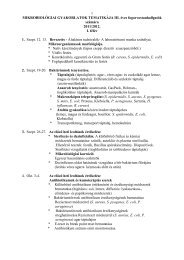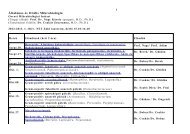Gram positive sporenbildende Stäbchen
Gram positive sporenbildende Stäbchen
Gram positive sporenbildende Stäbchen
You also want an ePaper? Increase the reach of your titles
YUMPU automatically turns print PDFs into web optimized ePapers that Google loves.
I.<br />
<strong>Gram</strong>negative anaerobe<br />
<strong>Stäbchen</strong><br />
II.<br />
<strong>Gram</strong> <strong>positive</strong> <strong>sporenbildende</strong><br />
<strong>Stäbchen</strong><br />
Dr. Bános Zsuzsa<br />
17 November 2009
AEROB<br />
Bordetella<br />
Brucella<br />
Francisella<br />
GRAMNEGATIVE STÄBCHEN<br />
Pseudomonas<br />
Acinetobacter<br />
Legionella<br />
FAKULTATIV ANAEROB<br />
Haemophilus<br />
Pasteurella<br />
Familie:<br />
Enterobacteriaceae<br />
Vibrionaceae<br />
Cardiobacterium<br />
Eikenella<br />
Kingella<br />
Actinobacillus<br />
ANAEROB<br />
Bacteroides<br />
Prevotella<br />
Porphyromonas<br />
Fusobacterium<br />
MIKROAEROPHIL<br />
Campylobacter<br />
Helicobacter
<strong>Gram</strong>negative anaerobe <strong>Stäbchen</strong><br />
(Bacteroidaceae<br />
Bacteroidaceae)<br />
Gattung Art<br />
Bacteroides B. fragilis<br />
und weitere<br />
Prevotella P. intermedia<br />
P. melaninogenica<br />
und weitere<br />
Porphyromonas P. gingivalis<br />
P. asaccharolytica<br />
und weitere<br />
Fusobacterium F. nucleatum u.w.
P. gingivalis, Fusobakterien<br />
www.genomenewsnetwork.org
pharmacie.univ-lille2.fr<br />
Porphyromonas spp.
pharmacie.univ-lille2.fr<br />
Prevotella intermedia
pharmacie.univ-lille2.fr<br />
Prevotella intermedia
pharmacie.univ-lille2.fr<br />
Prevotella – schwarze Pigmente fluoreszieren
Prevotella melaninogenica<br />
pharmacie.univ-lille2.fr
Vorkommen und Krankheiten-1<br />
Normalflora<br />
- der Mundhöhle (Porphyromonas, Prevotella, Fusobacterium)<br />
- des Darmtraktes (Bacteroides, Fusobacterium)<br />
- des Respirationstraktes/Orophyarynx (Prevotella)<br />
- des Urogenitaltraktes (Prevotella)<br />
Endogene Infektion – Mischinfektionen<br />
Virulenzfaktoren<br />
Adhäsine<br />
Kapsel<br />
Exoenzyme (Hyaluronidase, Kollagenase, Neuraminidase)<br />
Exotoxine, Toxische Substanzen<br />
Endotoxin
Vorkommen und Krankheiten-2<br />
In der Mundhöhle<br />
- Fusospirochätose:<br />
Treponema vincentii + Fusobakterien<br />
- Angina Plaut-Vincent<br />
- Akute nekrotisierende geschwürsbildende Gingivitis<br />
-Gingivostomatitis<br />
-Parodontitis Porphyromonas, Prevotella<br />
-Zahnabszesse
www.lg1.ch<br />
Flora Plaut - Vincent, Angina Plaut-Vincent
Flora Plaut - Vincent, Angina Plaut-Vincent<br />
Das massenhafte gemeinsame Vorkommen<br />
von Fusobacterium-Arten und Treponema<br />
vincentii, (Bestandteile der normalen Haut- u.<br />
Schleimhautflora) kann zu Gewebsnekrosen<br />
u. damit zur Schaffung anaerober<br />
Gewebsverhältnisse führen. Folge sind<br />
Fusospirochätosen (= Fusoborreliosen) wie<br />
die Angina Plaut-Vincent, Stomatitis ulcerosa,<br />
Alveolarpyorrhö, Noma, Nosokomialgangrän,<br />
Balanitis circinata, Ulcus tropicum,<br />
Lungengangrän etc.<br />
www.lg1.ch
www.lg1.ch Mischflora: Fusobakterien und Treponemen
Flora Plaut - Vincent, Fusobacterium<br />
fusiforme und Treponema (Borrelia)<br />
vincentii<br />
Eine Mischung aus Fusobacterien und<br />
Treponemen (Borrelien) verursacht eine<br />
sogenannte Fusospirochätose welch sich als<br />
Pharyngitis oder Gingivitis manifestiert.<br />
Benannt nach den Bakteriologen Hugo Carl<br />
Plaut, 1858–1928, Hamburg und Jean Henry<br />
Vincent, 1862-1950, Bakteriologe und<br />
Epidemiologe, Paris.<br />
www.lg1.ch
webs.wichita.edu<br />
Höhle und Gingivitis
webs.wichita.edu<br />
Ulcerativ Gingivitis
Vorkommen und Krankheiten-3<br />
Nekrotische Abszessen, generalisierte, septische<br />
Krankheiten<br />
Bauchraum (Bacteroides, Fusobacterium)<br />
Peritonitis, intraabdominelle Abszesse, Leberabszesse<br />
Respirationstrakt (Prevotella, Porphyromonas)<br />
Aspirationspneumonie, Lungenabszess, Pleuraempyem<br />
Urogenitaltrakt (Prevotella, Porphyromonas)<br />
Bakterielle Vaginose!<br />
Douglas-, und tuboovarielle - Abszess<br />
ZNS – Hirnabszesse (Prevotella, Porphyromonas)
Fig. 4.174 Acute peritonitis. Operating room photograph showing localized<br />
acute peritoneal inflammation with oedema, acute inflammatory exsudate,<br />
intense vascular congestion and petechiak haemorrhage, associated with acute<br />
cholecystitis. By courtesy of Dr. M. Anderson
Fig. 4.175 Acute<br />
peritonitis. Cloudy,<br />
infected peritoneal<br />
dialysate removed from a<br />
patient undergoing<br />
peritoneal dialysis.
Fig. 4.173 Appendiceal abscess. Ultrasound studies showing an<br />
abscess in the pouch of Douglas secondary to a ruptured appendix.<br />
Lateral view (left) and transverse view (right). By courtesy of Dr. A.E.<br />
Joseph
Fig. 4.176 Intraabdominal abscess. CT scan at the level of the seminal<br />
vesicles showing an elliptical abscess to the left of the midline.
Vorkommen und Krankheiten-3<br />
Nekrotische Abszessen, generalisierte, septische<br />
Krankheiten<br />
Bauchraum (Bacteroides, Fusobacterium)<br />
Peritonitis, intrabdominelle Abszesse, Leberabszesse<br />
Respirationstrakt (Prevotella, Porphyromonas)<br />
Aspirationspneumonie, Lungenabszess, Pleuraempyem<br />
Urogenitaltrakt (Prevotella, Porphyromonas)<br />
Bakterielle Vaginose!<br />
Douglas- und tuboovarielle Abszess<br />
ZNS – Hirnabszesse (Prevotella, Porphyromonas)
Fig. 2.91 Lung abscess. Chest radiographs,<br />
postanterior and lateral, showing abscess<br />
cavity in lower lobe of right lung.<br />
Abscess cavity<br />
Fig. 2.94 Large encysted empyema of right lung<br />
with additional small effusion.
Fig. 2.92 Lung abscess. <strong>Gram</strong> stain of pus showing <strong>Gram</strong>-<strong>positive</strong> cocci and<br />
varoius <strong>Gram</strong> negative and <strong>Gram</strong> <strong>positive</strong> rods. By courtesy of J.R. Cantey
Vorkommen und Krankheiten-3<br />
Nekrotische Abszessen, generalisierte, septische<br />
Krankheiten<br />
Bauchraum (Bacteroides, Fusobacterium)<br />
Peritonitis, intrabdominelle Abszesse, Leberabszesse<br />
Respirationstrakt (Prevotella, Porphyromonas)<br />
Aspirationspneumonie, Lungenabszess, Pleuraempyem<br />
Urogenitaltrakt (Prevotella, Porphyromonas)<br />
Bakterielle Vaginose!<br />
Douglas-, tuboovarielle-Abszess<br />
ZNS – Hirnabszesse (Prevotella, Porphyromonas)
Fig. 7.21 Bacterial vaginosis. The clue-cell – a vaginal epithelial cell<br />
with attached microorganism. The attached bacteria give the clue cell a<br />
stippled appearance. By courtesy of Dr. R.J.Arko and Prof G.P. Schmid
Fig. 7.90 Tuboovarian abscess. Ultrasound study of left sagittal section of the<br />
pelvis showing complex thick-walled cystic left adnexal man with internal<br />
septation.
Vorkommen und Krankheiten-4<br />
Diagnostik<br />
Nachweis des Erregers<br />
Direkt mikroskopisch (Angina Plaut-Vincent)<br />
Kultur<br />
Unter streng anaeroben Bedingungen<br />
Untersuchungsmaterial: Eiter, Exsudat – Entnahme! Anaerobe<br />
Transportmedien<br />
Inkubationszeit: 1-2 Woche<br />
Nachweis organischer Säuren im Medium Gaschromatographie<br />
Antibiogramm!<br />
Behandlung<br />
Penicilline (Amoxycillin+Clavulansäure) + Metronidasol
II.<br />
<strong>Gram</strong> <strong>positive</strong><br />
<strong>sporenbildende</strong> <strong>Stäbchen</strong><br />
Dr. Bános Zsuzsa<br />
17 November 2009
<strong>Gram</strong> posit po itive <strong>Stäbchen</strong><br />
Nicht Sporenbildende<br />
AEROB<br />
Corynebacteria<br />
C. diphtheriae<br />
diphtheroide<br />
C. jeikeium<br />
Listeria monocytogenes<br />
Erysipelothrix rhusiopathiae<br />
ANAEROB<br />
Lactobacillus spp.<br />
Sporenbildende<br />
AEROB<br />
Genus: Bacillus<br />
B. anthracis<br />
B. cereus<br />
B. subtilis<br />
ANAEROB<br />
Genus: Clostridium<br />
C. tetani<br />
C. botulinum<br />
C. difficile<br />
Gasbrand Clostridien
<strong>Gram</strong> posit po itive <strong>Stäbchen</strong><br />
Sporenbildende<br />
AEROB<br />
Genus: Bacillus<br />
B. anthracis<br />
B. cereus<br />
B. subtilis<br />
ANAEROB<br />
Genus: Clostridium<br />
C. tetani<br />
C. botulinum<br />
C. difficile<br />
Gasbrand Clostridien
<strong>Gram</strong> posit po itive <strong>Stäbchen</strong><br />
Sporenbildende<br />
ANAEROB<br />
Genus: Clostridium<br />
Gasbrand Clostridien<br />
C. tetani<br />
C. botulinum<br />
C. difficile<br />
AEROB<br />
Genus: Bacillus<br />
B. anthracis<br />
B. cereus<br />
B. subtilis<br />
Toxinbildung!
Clostridien<br />
SIND<br />
- Begeisselte Bakterien (Ausnahme: C. perfringens – KAPSEL)<br />
- Anaerobe<br />
- Resistent - Sporen gegen Hitze hochresistent!<br />
Sie ertragen 100°C 3-5 Stunden lang, 140°C trockene<br />
Wärme 1 Std lang<br />
BILDEN<br />
- Endosporen<br />
- Speziesspezifische Exotoxine - Intoxikation
Gasbrand Clostridien<br />
C. perfringens, perfringens,<br />
C. novyi, novyi,<br />
C. septicum u.a.<br />
u.a<br />
Morphologie<br />
<strong>Gram</strong><strong>positive</strong> <strong>Stäbchen</strong><br />
Vorkommen<br />
Erdboden<br />
Darmtrakt der Menschen<br />
und Tiere
Clostridium perfringens<br />
Kultur<br />
Blutagar: doppel-Haemolyse (α + β); relativ aerotolerant
Clostridium perfringens<br />
Pathogenese<br />
1. Verletzungen, Trauma<br />
2. Kontamination (mit Sporen)<br />
3. Vermehrung der Keime unter anaeroben Bedingungen<br />
im traumatisch veränderten Muskelgewebe<br />
4. Toxinbildung<br />
Anaerobe Zellulitis<br />
Nekrotisierende Myositis +<br />
+ Allgemeinintoxikation<br />
<br />
Gasbrand<br />
Schock<br />
Tod
Clostridium perfringens<br />
Typ: A, B, C, D und E<br />
Toxine<br />
α – δ: letale, nekrotisierende,<br />
haemolytische, zell-lysierende<br />
Wirkung<br />
(α-Toxin = Lecithinase)<br />
Enterotoxin<br />
Enzyme<br />
Kollagenasen<br />
Hyaluronidase<br />
DNasen<br />
Proteinasen<br />
Perfringolysin
Clostridium perfringens<br />
Krankheitsbilder<br />
Gasbrand (Typ A) mit andere Clostridien<br />
Darmbrand (Typ C)<br />
– Enteritis necrotisans ulcerosa<br />
Lebensmittelvergiftung<br />
– durch im Darmtrakt gebildete Enterotoxin<br />
Mischinfektionen mit andere Bakterien<br />
- Anaerobe Zellulitis
Fig. 10.46 Postoperative<br />
gangrenous cellulitis. A huge<br />
area of ulceration filled with<br />
gangrenous skin and slought<br />
lies adjancent to the wound.<br />
There is surrounding cellulitis<br />
and a further area of necrotic<br />
skin in the flank.<br />
Fig. 10.47 Postoperative<br />
gangrenous cellulitis. Same<br />
patient as Fig. 10.46 later.<br />
The cellulitis has resolved and<br />
the ulcerated area is filled with<br />
black necrotic tissue.
Fig. 10.49 Clostridial cellulitis, following compound fracture of the tibia. Crepitus<br />
was noted on examination and the presence of gas was confirmed radiologically.
Fig. 10.53 Gas gangrene. Amputation stump with discolouration of skin and<br />
haemorrhagic bullae typical of gas gangrene. By courtesy of Dr. J. Newman.
Gas gangrene evident in a patient's leg stump following<br />
amputation (Pelczar, Chan & Grieg, 1993, pp. 747) www.podiatry.curtin.edu.au
Fig. 10.54 Gas gangrene. There is a serosanguinous discharge from the lower<br />
end of the surgical wound and the affected muscles show pallor and failure to<br />
bleed. By courtesy of Mr. E. Taylor.
www.ooze.com
www.worldortho.com
Fig. 10.51 Fournier’s gangrene. Extensive necrosis of the skin and subcutaneous<br />
tissues of the scrotum and abdominal wall in a diabetic man. The presence of<br />
necrosis extending beyond the upper margin of the wound shows that<br />
insufficient debriment has been preformed and further surgery is necessary.
www-instruct.nmu.edu
Clostridium perfringens<br />
Krankheitsbilder<br />
Gasbrand (Typ A) mit andere Clostridien<br />
Darmbrand (Typ C)<br />
– Enteritis necrotisans ulcerosa<br />
Lebensmittelvergiftung<br />
– durch im Darmtrakt gebildete Enterotoxin<br />
Mischinfektionen mit andere Bakterien<br />
- Anaerobe Zellulitis
W482 – Enteritis necrotisans in large bowel. Extensive sloughing and necrosis,<br />
after consumption of insufficiently cooked pork.
www.3tres3.com<br />
Enteritis necrotisans
Fig. 4.55 Necrotizing enteritis. (pi-bel) Gross specimen of small bowel from a<br />
case seen in Uganda. The lower piece of opened jejunum shows greyish-black<br />
areas of necrosis, particularly involving the superficial part of the tranverse<br />
mucosal folds. By courtesy of Professor M.S.R. Hutt.
GASBRAND<br />
Diagnose<br />
Klinisch!!!<br />
Erregernachweis<br />
Mikroskopisch<br />
Kultur – Blutagar
GASBRAND<br />
<strong>Gram</strong> Färbung<br />
Exsudat
Histologie<br />
Gas<br />
GASBRAND<br />
Myonekrose
GASBRAND<br />
Speziesdiagnose der Clostridien:<br />
Biochemische Leistungen<br />
Gaschromatographie<br />
Differenzierung von Typen: Spezifisches Antiserum<br />
hemmt die letale Wirkung ihrer Toxine<br />
Toxinneutralisation in Meerschweinchen<br />
Nagler-test
Fig. 4.54 Nagler’s<br />
reaction detects the<br />
lecithinase produced by<br />
C. perfringens which<br />
gives a precititate in<br />
egg-yolk media. There<br />
are two parallel streams<br />
of growth. Zones of<br />
opacity are seen on the<br />
right half but not on the<br />
left, on which antitoxin<br />
was placed before<br />
inoculation.
GASBRAND<br />
Therapie<br />
Chirurgisch!!!<br />
Penicillin G i.v.<br />
Metronidazole<br />
Kombination: Breitspektrum Antibiotika (Mischinfektionen!)<br />
Alternativen: Penicillin + Clindamycin; Chloramphenicol<br />
Behandlung mit hyperbaren O 2 in einer Überdruckkammer<br />
Prophylaxe<br />
Chirurgische – Wundtoilette<br />
Penicillin, Cephalosporine<br />
Hospitalinfektionen! – Gips!
Clostridium tetani<br />
Morphologie<br />
„Trommelschläger”<br />
www.textbookofbacteriology.net
Clostridium tetani<br />
Kultur<br />
Unter anaeroben Bedingungen<br />
Blutagar – keine Haemolyse
Clostridium tetani<br />
Pathogenese, Infektion<br />
Vorkommen<br />
- Darm der Pflanzenfresser (Pferd! – Menschen selten)<br />
- Sporen gelangen in den gedüngten Erdboden, in den<br />
Strassenstaub, in den Wohnungstaub<br />
Infektionsquelle<br />
- Sporenhaltiger Staub,<br />
- Kontaminierte Instrumente<br />
Eintrittspforte<br />
- Verletzte Haut – Unfälle, Postoperativ<br />
- Auskeimung – Vermehrung – Toxinbildung
Clostridium tetani<br />
Tetanustoxin<br />
A-B Toxin<br />
Leichte Kette (A): Zink-Metalloprotease<br />
Schwere Kette (B): Bindung an motorischen<br />
Neuronen<br />
DLM: 1 ng/kg (Maus)<br />
A Kette gelangt retroaxonal in das Rückenmark, wird<br />
von Hemm-Neuronen aufgenommen, zerstört durch<br />
Proteolyse Synaptobrevine keine inhibitorische<br />
Impulse auf die motorische Neurone Spasmen der<br />
Skelettmuskeln
Clostridium tetani<br />
Krankheit<br />
Tetanus = Starrkrampf<br />
Tonische Spannung de Kiefer- und Gesichtsmuskeln<br />
mit Kieferklemme = Trismus<br />
Die gespannte Nacken- und Rückenmuskulatur führt<br />
zur Zwangshaltung mit hohlem Rücken:<br />
Opisthotonus<br />
Letalität: >50%
Fig. 3.122 Tetanus. Risus<br />
sardonicus, due to spasm<br />
of the facial muscles. By<br />
courtesy of Dr. T.F.<br />
Sellers, Jr.
Fig. 3.123 Tetanus. Risus<br />
sardonicus in a newborn<br />
infant.
Fig. 3.124 Tetanus. Risus<br />
sardonicus in an adult.
Fig. 3.121 Tetanus. Opisthotonus in an infant due to intense<br />
contraction of the paravertebral muscles. By courtesy of Dr. T.F.<br />
Sellers, Jr.
Sir Charles Bell’s portrait of a soldier dying of tetanus<br />
www.textbookofbakteriology.net
Clostridium tetani<br />
Immunität – keine<br />
(Toxin ist hochwirksam als Antigen aber zu gering)<br />
Diagnose<br />
- Erregernachweis<br />
in Wundsekret<br />
Gewebestücke<br />
-Kultur<br />
- Toxinnachweis<br />
im Wundmaterial<br />
(Tierversuch)<br />
Fig. 3.120 This organism is a slender bacillus forming<br />
terminal spores giving a „drumstick” appearence.<br />
<strong>Gram</strong> stain. Sporeformation in tissues.
Clostridium tetani<br />
Therapie<br />
Chirurgisch<br />
Symptomatisch (Curare)<br />
Antibiotika: Penicillin<br />
Passive Immunisierung - Tetanus Immunglobulin von Menschen<br />
Prophylaxe<br />
Aktive Immunisierung (Toxoid)<br />
Grundimmunisierung: ab 3. Lebensmonat – 11-15 Jahre<br />
Auffrischungsimpfung: in Abständen von 10 Jahren<br />
Bei Verletzungen<br />
A) vollständig immunisierter Personen: Auffrischimpfung (Toxoid)<br />
B) nicht immunisierter Personen: Simultanimmunisierung<br />
(Aktive+Passive)
Clostridium botulinum<br />
Morphologie<br />
„Tennisschlägerform”<br />
Vorkommen: Erdboden<br />
Botulinustoxin = Neurotoxin<br />
DLM ca. 1 ng/kg (Mensch)<br />
Typ: A, B, C1, C2, D, E, F<br />
Wirkung<br />
Blockade der Acethylcholinproduktion an den<br />
neuromuskulären Endplatten Paralyse
Clostridium botulinum<br />
Pathogenese<br />
Aufnahme von Lebensmittelnn in denen C. botulinum TOXIN<br />
gebildet hat<br />
Krankheitsbild<br />
Progressive Bulbärparalyse<br />
Diagnose<br />
TOXINNACHWEIS – im Tierversuch<br />
(Mageninhalt, Blutserum, Nahrungsmittel)<br />
Typ wird im Neutralisationstest bestimmt<br />
Behandlung<br />
Antitoxin (gegen Typ A, B, E) – schnell!
Fig. 3.125 Botulism. Clinical photograph showing dilated, unreactive,<br />
fixed pupils. By courtesy of Dr. Z. McGee.
Fig. 3.126 Botulism. Clinical photograph showing dry, furrowed tongue.<br />
By courtesy of Dr. Z. McGee.
Clostridium difficile<br />
Vorkommen:<br />
Darmtrakt 1-4 % Erwachsene; 30-50% Kleinkinder<br />
Virulenzfaktoren<br />
Toxin A: Enterotoxin<br />
Toxin B: Zytotoxin<br />
Behandlung mit Breitspektrumantibiotika<br />
Pseudomemranöse Colitis<br />
Therapie:<br />
Aufhören mit Antibiotikum Behandlung<br />
Per os Metronidazole, Vancomycin
Fig. 4.56 Antibiotic-associated colitis. <strong>Gram</strong><br />
stain of faeces showing large gram-<strong>positive</strong><br />
spore-forming rod-sheped cells of C. difficile,<br />
along with small numbers of gram-negative<br />
organisms any many inflammatory cells. By<br />
courtesy of Dr. R. Fekety
Fig. 4.57 Gross specimen of colons from fatal cases of antibiotic-associated colitis. Right:<br />
Extensive inflammatory pseudomembrane. Middle: numerous small plaques, some almost<br />
confluent. Left: Confluent pseudomembrane covering most of the epithelial surface.
Fig. 4.58 Macroscopic appearance of typical pseudomembranous colitis<br />
showing the discrete yellow plaques.
Fig. 4.59 Sigmoidoscopic view of pseudomembranous colitis<br />
due to antibiotic treatment. The yellow-white „membrane”<br />
contrast with the reddened colonic mucosa. By courtesy of<br />
Prof. R. Hunt
Fig. 4.60 Sigmoidoscopiv view demonstrating multiple pseudomembranous<br />
lesions in a patient with antibiotic-associated colitis due to C. difficile.
Fig. 4.64 Antibiotic-associated colitis. Assay of C. difficile toxin showing normal<br />
baby-hamster kidney cells (left) and cells after exposure to toxin (right). Note<br />
rounding up of cells following exposure to toxin. By courtesy of Dr. R. Fekety
<strong>Gram</strong> posit po itive <strong>Stäbchen</strong><br />
Sporenbildende<br />
AEROB<br />
Genus: Bacillus<br />
B. anthracis<br />
B. cereus<br />
B. subtilis<br />
ANAEROB<br />
Genus: Clostridium<br />
C. tetani<br />
C. botulinum<br />
C. difficile<br />
Gasbrand Clostridien
Morphologie:<br />
<strong>Gram</strong> +<br />
sporenbilden<br />
de, 5-10 μm,<br />
dicke,<br />
<strong>Stäbchen</strong><br />
Bacillus anthracis<br />
www.textbookofbacteriology.net
<strong>Gram</strong> Färbung<br />
B. anthracis B. subtilis
Sporenfärbung - Ziehl Neelsen
Kultur:<br />
einfach<br />
Bacillus anthracis<br />
www.textbookofbacteriology.net<br />
Blutagar
B. anthracis - Blutagar
Ag / Virulenzfaktoren:<br />
KAPSEL (D-glutaminsäure)<br />
TOXINE:<br />
Oedemafaktor (EF)<br />
Letalfaktor (LF)<br />
+ Protectives Antigen (PA)<br />
www.textbookofbacteriology.net<br />
Bacillus anthracis
Source: Medmicro<br />
Toxinbildung<br />
Zellmembran
Pathogenese<br />
Bacillus anthracis<br />
Zoonose!<br />
Infektionsquelle:<br />
• Tiere (Kranke, Cadaver), tierische Produkte<br />
• Erdboden (Sporen)<br />
Eintrittspforte:<br />
• Mucosa<br />
• Haut (Verletzungen)<br />
Übertragung: nicht Kontagiös
Bacillus anthracis<br />
Krankheitsbilder: Anthrax = Milzbrand<br />
•Hautanthrax (direkt, Wunden) – Pustula maligna<br />
•Lungenanthrax (Inhalation von Sporen)<br />
•Darmanthrax (direkt, kontaminiertes Lebensmittel)<br />
•Sepsis (Letalität 5-20%)<br />
Diagnose:<br />
Erregernachweis: mikroskopisch, Kultur<br />
Therapie:<br />
Penicilline<br />
Lungen - Darmanthrax: Ciprofloxacin + Penicillin<br />
(lange: 60 Tage!)
Hautanthrax I. - Pustula<br />
maligna
Source: CDC Anthrax Images<br />
Hautanthrax II.
Hautanthrax III.<br />
Source: CDC Anthrax Images Local laesion + oedema
Pustula maligna<br />
+ Oedema<br />
Fig. 10.97 Anthrax. The eschar can be seen on the lower eyelid and there<br />
is extensive oedemaof the face. By courtesy of Dr. T.F. Sellers, Jr.
Pustula maligna und Oedema
Bacillus anthracis<br />
Krankheitsbilder:<br />
• Hautanthrax (direkt, Wunden) – Pustula maligna<br />
• Lungenanthrax (Inhalation von Sporen)<br />
• Darmanthrax (direkt, kontaminierte Lebensmittel)
Inhalation/Lungenanthrax (X-ray)<br />
Mediastinal widening<br />
Source: CDC Anthrax Images<br />
… and pleural effusion
Prophylaxe<br />
• Vernichtung infektiöser Tiere<br />
• Dekontamination von Erdboden, Desinfektion<br />
kontaminierter Produkte<br />
• Aktive Immunisierung: Zellfreie Vakzine<br />
- Risikogruppen: Armee (USA), Tierärzte<br />
• Chemoprophylaxe der Lungenanthrax:<br />
Kontaktpersonen, Ciprofloxacin<br />
WHO Meldepflicht<br />
Bioterrorismus!<br />
Bacillus anthracis
Biologische Waffen - Zusammenfassung<br />
Biologische Waffen: Organismen, Toxine,<br />
Viren<br />
Ziel:<br />
• Individuen, ganze Populationen erkranken zu<br />
lassen oder gar auszurotten<br />
• Ökonomische schaden<br />
Biokriegsführung (militärische Konflikts)<br />
Bioterrorismus (ideologische Motive)<br />
Bioverbrechen (persönliche Ziele)
Biologische Waffen - Zusammenfassung<br />
Kap. X. 129. Tab. 129.1. (Hahn)<br />
Kategorie: A, B, C<br />
Gefährlichste: A<br />
B. anthracis, C. botulinum, F. tularensis, Y. pestis<br />
Einfache Kultivierung<br />
Ausbreitung durch Atemwege<br />
Hohe Letalität<br />
Therapie?<br />
Plötzliche Auftreten<br />
Zahlreiche Fälle
Verbreitung von Anthrax<br />
Jet<br />
Theoretisch<br />
Wind<br />
Und<br />
Regen<br />
Forrás: anthrax BBC tények<br />
Briefe<br />
Realität<br />
Billig, aber fliegende Sporen??<br />
USA 2001<br />
10 Lungenmilzbrand<br />
7 Hautmilzbrand<br />
5 Todesfälle
Biologische Waffen und Anthrax<br />
Aufzählung<br />
Forrás: anthrax BBC tények<br />
Unfall<br />
Japanische Terroristen
B. cereus<br />
Vorkommen<br />
-Ubiquitär<br />
BILDET<br />
- Enzyme (Kollagenase, Proteasen, Amylase,<br />
Phospholipase, Lecithinase, Haemolysin)<br />
- Enterotoxin<br />
Lebensmittelvergiftung<br />
(Emetisches und Diarrhoe – Toxin)<br />
Wund – Generalisierte Infektionen
B. subtilis<br />
Wundinfektion – Stichverletzungen des Auges durch<br />
Stroh, erdbehaftete Fremdkörperverletzungen<br />
Differenzierung von B. anthracis!<br />
Sie sind nicht bekapselte, bewegliche Keime,<br />
rufen β-Haemolyse hervor, sind apathogen in<br />
Tierversuch
Mauritius, 2006<br />
ENDE



